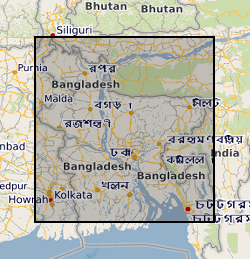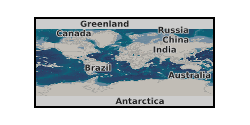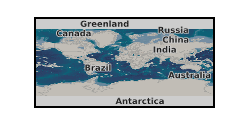University of Birmingham
Type of resources
Topics
Keywords
Contact for the resource
Provided by
Years
Formats
Representation types
Update frequencies
Resolution
-
This dataset contains information about submersible absorbance sensor responses to varying suspended sediment concentration, grain size and organic content. Laboratory tests were conducted at the University of Birmingham, UK, during 2023 as part of a wider study developing methods for urban storm flow characterization. Two sediment types were assessed along with three size fractions across concentration ranges from 0 mg/L to 5000 mg/L. Absorbance was recorded at key wavelengths between 190 – 360 nm and particle size distribution and organic content (loss on ignition) measured for each sediment type and size fraction. The work was supported by the Natural Environment Research Council (Grant NE/X011178/1). Full details about this dataset can be found at https://doi.org/10.5285/ee577b07-1a2c-4541-bf30-e2ea048e15e1
-
This dataset contains fitness-linked life history traits, environmental data, and protein and gene expression data for Daphnia magna. Life history data were measured in common garden experiments. For each clone of the same genotype across all experiments, size at maturity (distance between the head and the base of the tail spine), age at maturity (first time eggs were observed in the brood chamber), fecundity (total number of offspring released summing first and second brood), and mortality were measured. Critical thermal maximum (CTmax) was measured on the experimental animals. Environmental data consisted of Secchi disk depth (water transparency) ; total phosphorous; and total nitrogen for the years 1971–1999; a record of pesticides 1955–2010; temperature records over the past century 80 km from Lake Ring. Organic and carbonate contents of the sediment was estimated using the loss on ignition (LOI) method. Hb protein data consisted of constitutive Hb protein crude content animals reared in normoxic (saturated oxygen level) conditions at two experimental temperatures, 20 and 30°C. Heat shock protein expression was measured in four heat shock proteins (HSP20, HSP60, HSP70 and HSP90). Total RNA, qPCR, mean CT (cycle threshold) value per sample and per protein were collected. Full details about this dataset can be found at https://doi.org/10.5285/13f878dc-ef87-45d5-be8c-5733c88c30e9
-

This dataset contains data from a river multibeam and seismic survey which took place in 2013 and 2014 at scour sites within the Brahmaputra river basin in Bangladesh. The survey was carried out as part of a joint project between the Universities of Birmingham, Southampton and Exeter. "The sedimentology of fluvial megascours" was a scientific research project funded by NERC. The purpose was to collect the data necessary to validate the first generic numerical model of scour zone stratigraphy that will be widely applicable to a broad range of large rivers. River bed bathymetry data were collected using a multibeam echosounder. Sub bottom seismic profiling data were collected using a surface tow boomer and chirp system. Technical details of the survey are contained in the cruise report of the survey which comprises part of the metadata. Some of the data has been accepted for a publication in the journal 'Sedimentology' which will be published in 2018 with the title 'The Sedimentology of channel confluences'.
-
This dataset contains breakthrough curves of conservative (fluorescein) and reactive (resazurin and resorufin) tracers resulting from instantaneous tracer experiments in a lowland agricultural stream. Breakthrough curves were measured seasonally at four locations within the stream, creating three experimental reaches, in the Wood Brook, Staffordshire from July 2016 to March 2017. Breakthrough curves were measured in-situ using on-line fluorometers configured to measure the excitation of fluorescein, resazurin and resorufin every 10 seconds. The breakthrough curves were measured to determine hydrological metrics of advective transport, transient storage and aerobic respiration. The work was funded by the Natural Environment Research Council, UK through a through a Central England NERC Training Alliance Studentship and grant NE/L004437/1, with additional funding provided by the European Union through the H2020-MSCA-RISE-2016 project 734317. Full details about this dataset can be found at https://doi.org/10.5285/5b34d963-d0f0-465e-b395-e955b89e1cd7
-
The dataset contains carbon dioxide and methane emissions, as well as resorufin production (as a proxy for microbial metabolic activity) and dissolved oxygen concentrations, resulting from laboratory incubation experiments of streambed sediments. The sediments were collected from the upper 10 centimetres of the streambed in the River Tern and the River Lambourn in September 2015, with three samples collected from each river. These samples were collected from three areas: silt-dominated sediment underneath vegetation (fine), sand-dominated sediment from unvegetated zones (medium) and gravel-dominated sediment from unvegetated zones (coarse). The sediment was used in laboratory incubation experiments to determine the effect of temperature, organic matter content, substrate type and geological origin on streambed microbial metabolic activity, and carbon dioxide and methane production. The work was carried out as part of a Natural Environment Research Council (NERC) funded PhD (NERC award number 1602135). The work was also part funded through the Seventh Framework Programme (EU grant number 607150). Full details about this dataset can be found at https://doi.org/10.5285/3a0a5132-797c-4ed5-98b9-1c17eaa2f2b7
-

Elemental and stable isotope data measured in Eocene foraminiferal calcite from Ocean Drilling Program Site 865 and Tanzanian Drilling Project Site 18 published in Edgar et al. (2015) "Assessing the impact of diagenesis on δ11B, δ13C, δ18O, Sr/Ca and B/Ca values in fossil planktic foraminiferal calcite" in Geochimica et Cosmochimica Acta, v. 166, p. 189-209. Table 1. δ18O and δ13C values for glassy and frosty foraminifera from TDP Site 18 and ODP Site 865, respectively. Table 2. Sr/Ca and B/Ca values, and test weights for glassy and frosty foraminifera from TDP Site 18 and ODP Site 865, respectively. Table 3. δ11B values for glassy and frosty foraminifera from TDP Site 18 and ODP Site 865, respectively.
-

Major and trace element data for partial melts derived from high pressure-temperature experiments on a basaltic starting composition from the Ontong Java Oceanic Plateau.
-

Collection of data from the PhD Thesis 'Development of coupled processes numerical models of tracer, colloid and radionuclide tranpsort in field migration experiments', submitted as part of the RATE HydroFrame WP5. This collection of data includes blank model files in COMSOL Multiphysics and PHREEQC, as described in the PhD thesis. Also included in this data package are different spreadsheets with model outputs from the model files that describe the transport of conservative tracers, colloids and radionuclides in experiments carried out at the Grimsel Test Site, Switzerland as part of the Colloid Radionuclide and Retardation (CRR) and the Colloid Formation and Migration (CFM) experiments (www.grimsel.com).
-

The stratigraphic scope of the data is 1) the Polarisbreen Group of NE Svalbard (late Tonian to Ediacaran) and 2) top Appin and lower Argyll Groups, western Scotland (late Tonian to Cryogenian). Geochemical data on carbonates includes, in different cases, stable oxygen and carbon isotopes, strontium isotopes and trace elements. Results from Scotland are published in: Fairchild, I.J., Spencer, A.M., Ali, D.O., Anderson, R.P., Anderton, R., Boomer, I., Dove, D., Evans, J.D., Hambrey, M.J., Howe, J., Sawaki, Y., Wang, Z., Shields, G., Skelton, A. Tucker, M.E. and Zhou, Y. 2017 Tonian-Cryogenian boundary sections of Argyll, Scotland. Precambrian Research. doi: 10.1016/j.precamres.2017.09.020. An additional plot of some of the data is in: Ali, D.O., Spencer, A.M., Fairchild, I.J., Chew, K.J., Anderton, R., Levell, B.K., Hambrey, M.J., Dove, D., Le Heron, D.P. 2018. Indicators of relative completeness of the glacial record of the Port Askaig Formation, Garvellach Islands, Scotland. Precambrian Research. Doi: 10.1016/j.precamres.2017.12.005. Results from Svalbard are partly published (Elbobreen Formation, members 3 and 4; Wilsonbreen Formation) in the publications listed below. Data on Elbobreen Formation, members 1 and 2 and the Dracoisen Formation are not published at the time of writing (January 2018). Fairchild, I.J., Bonnand, P., Davies, T., Fleming, E.J., Grassineau, N., Halverson, G.P., Hambrey, M.J., McMillan, E.A., McKay, E., Parkinson, I.J. and Stevenson, C.T.E. 2016 The Late Cryogenian Warm Interval, NE Svalbard: chemostratigraphy and genesis of dolomitic shales. Precambrian Research, 281, 128-154. Fairchild, I.J., Fleming, E.J., Bao, H., Benn, D.I., Boomer, I., Dublyansky, Y.V., Halverson, G.P., Hambrey, M.J., Hendy, C., McMillan, E.A., Spötl, C., Stevenson, C.T.E. and Wynn, P.M. 2016 Continental carbonate facies of a Neoproterozoic panglaciation, NE Svalbard. Sedimentology, 63, 443-497. Benn, D.I., Le Hir, G., Bao, H., Donnadieu, Y., Dumas, C., Fleming, E.J., Hambrey, M.J., McMillan, E.A., Petronis, M.S., Ramstein, G., Stevenson, C.T.E., Wynn, P.M. and Fairchild, I.J. 2015 Orbitally forced ice sheet fluctuations at the end of the Marinoan Snowball Earth glaciation Nature Geoscience. 8, 704-707. Fleming, E.J. (2014) Magnetic, Structural and Sedimentological Analysis of Glacial Sediments: Insights from Modern, Quaternary and Neoproterozoic Environments. Unpublished PhD Thesis. University of Birmingham. Available at: http://etheses.bham.ac.uk/5136/
-
The dataset contains chemistry data from streambed porewater (10 and 20 cm) and surface water, as well as nitrogen chemistry data at 2.5 cm resolution within the upper 15 cm of the streambed. The dataset includes concentrations of dissolved organic carbon (DOC), carbon dioxide, methane, ammonium, nitrate, nitrite and nitrous oxide, and isotopic ratios of δ13CCO2, δ15NNO3+NO2 and δ18ONO3+NO2. Also included are measurements of dissolved oxygen and temperature. Samples were collected from three reaches within the stream, an upstream sandy reach, a mid-stream sandy reach and a downstream gravel reach. The work was carried out with Natural Environment Research Council (NERC) funding through a PhD (NERC award number 1602135), grant (NE/L004437/1) and Life Sciences Mass Spectrometry Facility grant (CEH_L102_05_2016). Full details about this dataset can be found at https://doi.org/10.5285/00601260-285e-4ffa-b381-340b51a7ec50
 NERC Data Catalogue Service
NERC Data Catalogue Service